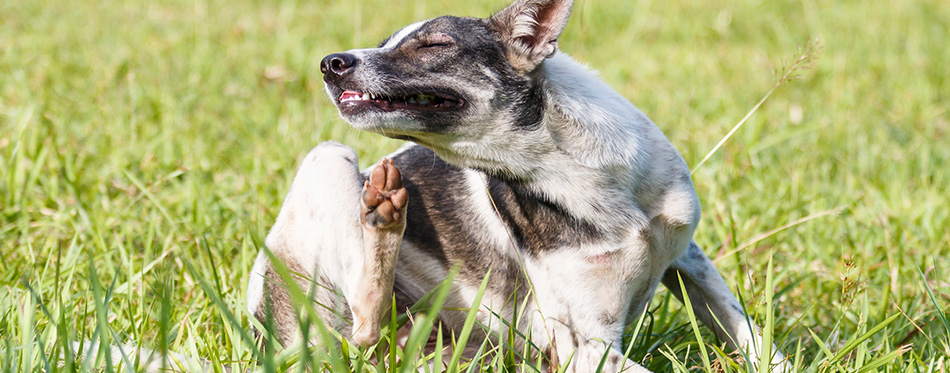For their tiny size, the flea can bring a whole lot of trouble for your dog if an infestation manages to take hold. Your poor pooch will be driven to distraction and if left untreated can go on to develop anemia as well as run the risk of skin infections.
The best way to manage a flea outbreak is to nip it in the bud as soon as you can. To help, we’ve taken a look at how fleas can affect your pet and the key signs that your best friend has some unwanted tiny hitchhikers on board. Just these few simple steps and you can help to keep your dog happy and flea-free. And, if he could, we’re sure he’d thank you for it.

The Lowdown On Fleas
The most common flea infestation in dogs is not actually a canine flea at all, but the cat flea – also known as the Ctenocephalides felis. The cat flea infests over 50 different mammal and bird species, with their favorite animal hosts in the US being dogs, cats, foxes, raccoons and domestic rabbits. The flea’s ‘free and easy’ approach when it comes to their hosts means they are spread widely around our everyday lives, making it easy for your pet to inadvertently pick one up as they go about their normal routine. The actual dog flea (Ctenocephalides canis) is rarer but can still be picked up by your pooch and is a little more problematic as it can also spread tapeworm. Fleas can also cause anemia in your pet if left untreated as well as make him pretty darn miserable.
Fleas are tiny but can be seen with the human eye – they are a dark brown and typically measure around 1mm. They can live for 7-14 days on their chosen host, latching on to your dog to feed off their blood. Adult female fleas will also lay eggs deep in the coat of your pooch, as many as 50 a day. Every time your pet shakes or scratches, flea eggs will be dislodged and fall into your carpet, flooring, pet bedding or around your garden, meaning that when you come to treating your pet for fleas, it’s essential that you treat your home too.
The Five Signs To Look Out For
If your dog is looking a little irritated, or you have perhaps forgotten to give him his latest flea treatment, then there’s a chance he may have picked up a bit of an infestation. If you can’t yet see any of the miniscule pesky critters but still suspect a problem, then here are the five main signs that your pooch has fleas:
Abnormal Scratching, Biting Or Licking
While all dogs like to have a good old scratch and a lick, obsessive or frantic grooming is a clear indication of something irritating their skin. A typical reaction to a flea nip is when your pet suddenly whips around to nibble at his own skin so take this as a tell-tale sign that your pooch is currently a buffet for a tiny, unwanted pest. If left, the itchiness of a flea infestation can become intense and like any irritation, the more they scratch, the worse your pooch can make it. Constantly biting and scratching can actually lead to an infection in the dog’s broken and scuffed, flea-bitten skin. The typical areas for fleas to inhabit are the dog’s head, neck, tail, armpits and groin so if your dog is repeatedly nibbling and scratching these parts, then that’s a sure sign he has some unwanted guests.
Unusual Red Spots Or Patches On The Skin
If you find large red patches or bumpy spots on your dog’s body that are also warm to the touch, then he could well have flea allergy dermatitis – the most common skin ailment caused by an infestation.
Also known as FAD, these angry raised areas are caused by your dog’s skin reacting to flea saliva as his immune system fights against antigens that have found their way into your pet’s system. FAD is most often seen in younger dogs, as it typically develops in the first five years of their life and, if left untreated, can get worse as the dog ages.
Hair Loss
Another indicator that there is a small irritant making a meal of your dog is if they start to lose excessive amounts of hair through shedding, leaving obvious bald patches in their fur.
Your pet could start to lose hair if they are constantly scratching their skin or rubbing against the carpet or other surfaces in a bid to ease the discomfort that is driving them wild. The good news about your pet’s sudden onset of baldness is that, once you have eradicated the fleas and brought any signs of FAD under control, its fur will grow back with no permanent loss of hair. You may see some slight color variations in their coat but there should be no other long-term effects on your pooch. The key is to treat the flea problem as soon as possible and within a couple of weeks your dog should be back to its full furry glory.

Small Reddish Or Brown Specs On Your Dog’s Skin
To not put a finer point on it, if you find small, reddish or brown specks on the surface of your pet’s skin, then you definitely have fleas in residence as this is their poo. A mix of dried blood and other fecal waste, flea dirt resembles fine dusty grounds and will stand out against the pale color of your dog’s skin.
If you suspect fleas, check their favorite haunts on your dog’s body for the tell-tale signs of flea dirt. Simply run your fingers or a dog flea comb against the direction of your dog’s fur, paying particular attention to the top of their tail, groin area, along their underside and around their ears. To be sure it’s from a flea rather than just the sign of a grubby dog that needs a bath, shake the dirt onto a paper towel and spray lightly with water. As it dissolves, flea dirt will turn a dark, reddish color, indicating the canine blood they have ingested. A bit yucky but proof that you have some unwanted critters on board.
Pale Gums
For their minute size, fleas have a voracious appetite for blood and can consume up to 15 times their own body weight of your dog’s red stuff. While a small infestation of fleas dealt with promptly is not going to do long-lasting harm, if your pet is not treated, he will over time lose quite a lot of blood. His red blood cell count could then drop, leading to a condition called regenerative anemia.
Pale gums are one sign of the condition, and if the infestation continues, they could also start to appear listless as their body struggles to replenish the red cells lost by fleas feeding on their blood. If your beloved pooch is showing these symptoms, then it’s a big sign they could well have a serious flea problem that needs urgent treatment.
How To Get Rid Of Fleas Pronto
If you have ticked off most or all of the five signs that your dog has fleas, then now’s the time to act. Not only do you need to treat your pet but also your home and your dog’s living environments to make sure he is not at risk of re-infestation, undoing all your hard work.
Here’s how to say adios to your dog’s flea problem:
- Treating your dog
There are a number of flea remedies out there and if you’re unsure, then your vet will be able to give you the best advice on what treatment is appropriate for your pet. Do not use any medication or flea treatment that is not indicated for the type of pet you have. If you also have cats in the home, they will need treatment too, but it is essential you don’t treat your dog near to your cat, as flea treatment products for dogs can be toxic for them.
The most common ways to get rid of your dog’s fleas are topical medicines, such as drops, shampoos or powders. Follow the instructions carefully and repeat if specified. You can also look to then use a flea collar to keep any re-infestation at bay. Prevention now is the way to go, so do chat to your vet about anti-flea prescription, as part of his regular health and worming program.
Related Posts: Flea Treatment for Dogs and Flea Collars for Dogs
- Treating your home
If your dog has fleas then as disgusting as it may sound, it’s likely your home has too. You will need to remove the critters from around your house if you are to prevent a ‘Groundhog Day’ situation, as your cleaned-up pooch picks up more fleas. Here’s a few tips to bust those unwanted house visitors once and for all:
- Thoroughly wash your dog’s bed and bedding, replace his blankets if you can
- Once you have vacuumed all the areas of your home your dog visits – including carpets, rugs and upholstery, discard the used vacuum bags immediately
- Make sure you clean all these areas in your home every few days for a couple of weeks to suck up any flea eggs that may be hanging on
- Regularly groom your pet with flea shampoo and a flea comb, checking for any signs of a return.
Related Posts: Flea Carpet Powders & Sprays and Vacuum for Pet Hair

And Finally….
When comes to the long-term management of the frisky flea, prevention is most definitely preferable to the cure. Discuss flea prevention treatment options with your veterinary practice the next time your dog has his health check-up. In the meantime, keep vigilant when it comes to the five key signs your pooch may have some unwanted flea friends.

